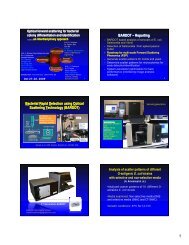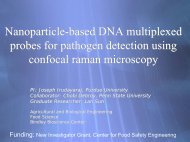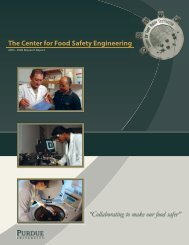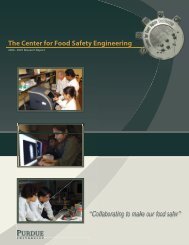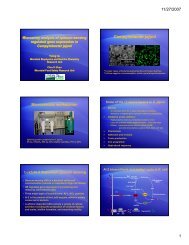Annual Report - Center for Food Safety Engineering - Purdue ...
Annual Report - Center for Food Safety Engineering - Purdue ...
Annual Report - Center for Food Safety Engineering - Purdue ...
Create successful ePaper yourself
Turn your PDF publications into a flip-book with our unique Google optimized e-Paper software.
Lu, Bhunia and ChengRapid, quantitative, and reusable immunosensors <strong>for</strong>bacteria detection on a microfluidic plat<strong>for</strong>mInvestigators: Chang Lu (Department of Agricultural and Biological <strong>Engineering</strong>), Arun Bhunia (Department of<strong>Food</strong> Science), Zhongyang Cheng (Materials <strong>Engineering</strong>, Auburn University)Project RationalePortable, rapid, and sensitive biosensors <strong>for</strong> food safetyapplications enable point-of-care contamination detectionand immediate interpretation of the results. In our researchproject, we proposed to develop an integrated biosensorsystem on a microfl uidic chip <strong>for</strong> detecting bacteria basedon immunoassays. The device will offer a sensitivity of 10 2to 10 3 bacteria cell detection and an assay time of fewer than20 minutes <strong>for</strong> a single test. Our system will yield quantitativedata <strong>for</strong> estimating the number of the target bacterium in a foodsample. The microfl uidic system will consist of individual devices<strong>for</strong> cell lysis, lysate purifi cation, and immunoassays. In principle,the tool will be effective <strong>for</strong> any bacterium or strain given theavailability of a suitable intracellular antigen-antibody pair. In thisproject, we will demonstrate the concept using an intracellularantigen, alcohol acetaldehyde dehydrogenase (Aad), and itsantibody MAb-H7 to detect Listeria monocytogenes. In order toconcentrate L. monocytogenes cells from food samples, we willfabricate magnetic nanobars with different sizes and geometriesand develop protocols <strong>for</strong> immobilizing antibodies specifi c to L.monocytogenes on the surface.A portable, reusable, and low-cost device would be useful<strong>for</strong> point-of-care analysis in the food manufacturing industry.Conducting bacteria detection tests within food manufacturinglaboratories would dramatically decrease the turnaroundtime <strong>for</strong> the results and avoid potential contamination andchanges in the bacteria during transit. Conventional analyticalmethods require bulky, expensive equipment that are oftencost-prohibitive <strong>for</strong> food manufacturing laboratories. With ourlab-on-a-chip approach, sophisticated functions of a biologicallaboratory can be miniaturized on a microchip, enabling anyminimally equipped laboratory with the ability to per<strong>for</strong>m bacteriadetection tests. This technology can signifi cantly benefi t the foodindustry by enhancing the laboratory-testing capabilities of foodmanufacturers and food testing laboratories as well as fi eldtestingactivities of governmental agencies.Project Objectives• Fabricate magnetic nanobars with different sizes andgeometries and develop protocols <strong>for</strong> immobilizingantibodies specifi c to L. monocytogenes on the surface.The amount of bacterial cells bound to the surfacewill be characterized under different conditions.• Develop an electrophoresis-based immunoassaycoupled with laser-induced fl uorescence on a microfl uidicchip. We will use this tool to quantitatively detect L.monocytogenes based on cell lysate via the interactionbetween alcohol acetaldehyde dehydrogenase(Aad) and its monoclonal antibody (MAb-H7).• Demonstrate a prototype-integrated microfl uidicsystem which incorporates different steps suchas manipulation of magnetic nanobars, cell lysis,lysate purifi cation, and immunoassay.Project HighlightsWe integrated the concentration, lysis, and competitiveimmunoassay <strong>for</strong> detecting L. monocytogenes on a microfl uidicchip. A packed bed of microbeads, with the bead surface coatedwith monoclonal antibody (MAb-H7) that is specifi c to the antigenListeria adhesion protein (LAP), was <strong>for</strong>med in a microfl uidicchannel to physically trap bacterial cells. Electrical lysis wasthen used to release intracellular materials from the trappedcells. Fluorescein isothiocyanate (FITC)-labeled LAP was fl owedthrough the microbead bed to bind to unreacted antibody sitesand reveal whether LAP was present in the bacterial sample. Byintegrating all these functions onto one simple portable chip, wecan produce a biosensor system that is both highly effi cient andinexpensive.12<strong>Center</strong> <strong>for</strong> <strong>Food</strong> <strong>Safety</strong> <strong>Engineering</strong>“By integrating all these functions onto one simple portable chip, we canproduce a biosensor system that is both highly effi cient and inexpensive.”






